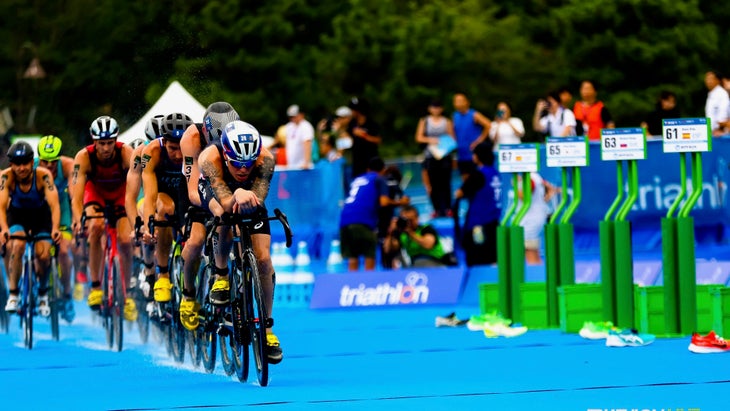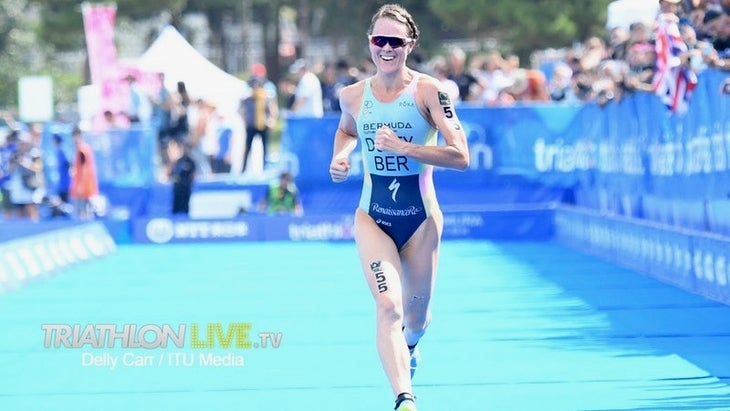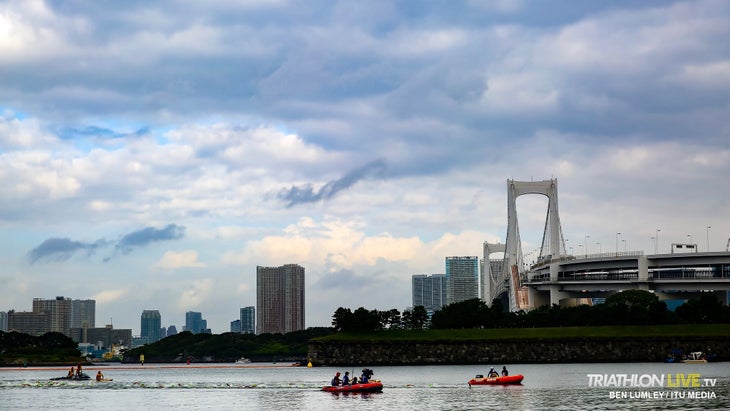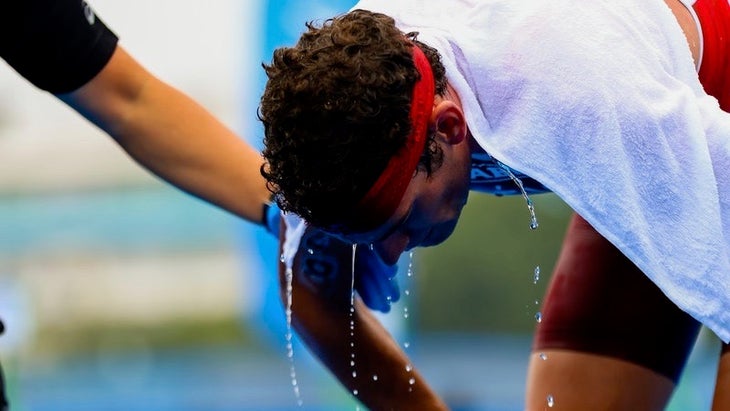New perk! Get after it with local recommendations just for you. Discover nearby events, routes out your door, and hidden gems when you sign up for the Local Running Drop.
Originally published May 12, 2021. Updated July 8.
With the Tokyo Olympics finally upon us, there are still some questions. How will it all work in the COVID era? Who gets to compete? How can I watch the Olympic triathlon races?
We’ll try to answer all your triathlon-related Olympics questions here. You can also check out all of our Olympics coverage.
Will there be an Olympics?
Almost definitely. IOC officials have strongly said the Games will move forward, even as there is a surge of COVID cases in Japan, vaccination rates in the country remain low, and the Japanese public has expressed concerns about the Olympics being held. A state of emergency was declared in Japan this week, and officials have said the Games will continue amidst this lockdown—but without spectators.
RELATED: How Will the Tokyo Olympics Happen? Should They?
Will there be spectators and media at the Olympics?
No foreign spectators will be allowed into the country, and media and official dignitaries are expected to be sharply curtailed (and have to adhere to strict safety protocols and heavily limit their movements). In June, Japanese officials said they wouldd allow domestic spectators and limit them to 10,000 or 50% capacity. However, a new state of emergency declared this week forced them to walk that back. There will now be no spectators allowed.
What kind of COVID protocols do the athletes have to follow?
Strict ones. With a number of protocols tested at the Yokohama event in May (and expanded on), Olympians can expect to be required to take multiple COVID tests in the 72 hours before arriving in Japan, install an app on their phone to track their movements and health status, update any symptoms daily via an app and/or phone calls, be limited or quarantined in their rooms except for designated training times, only be allowed to train at specific times and locations, and fill out a lot of paperwork to obtain a visa.
Olympic officials have also said athletes during the Games will be tested daily, while coaches and those in close contact with athletes will be tested “regularly.” Vaccination is not expected to be required, however.
When are the Olympic triathlon events?
Local time in Japan, the men’s triathlon race will be held on July 26 at 6:30 a.m. The women’s race is the next day at 6:30 a.m. on July 27. The Mixed Team Relay will be held on July 31 at 7:30 a.m.
What time is that in the U.S.?
If you want to watch in the U.S., those times correspond to: The men’s race will be at 5:30 p.m. ET on Sunday, July 25. The women’s race will be at 5:30 p.m. ET on Monday, July 26. And the Mixed Team Relay will be at 6:30 p.m. ET on Friday, July 30.
How long is the race?
In the Olympics the athletes race what has come to be known as the Olympic distance or standard distance–i.e., 1500m swim, 40K bike, and 10K run. That’s the same distance you likely race in your local Olympic-distance triathlons, but the major difference is that Olympic and World Triathlon races are draft-legal. (Read more about the origins of the Olympic distance for triathlon here.)
What does draft-legal mean?

In non-drafting triathlon—i.e., what most age-group athletes race and what is commonly seen in Ironman events—athletes are required to stay far apart on the bike leg. Typically rules dictate that you can not be within 12 meters of the cyclist ahead of you in order to avoid getting an advantage (or draft) from them blocking the wind. This is compared with pro cycling, where riders will stick in a peloton or in large packs or pace lines in order to draft off the cyclist ahead of them and gain a benefit.
Draft-legal triathlon allows the athletes to draft on the bike, which means an athlete can ride right behind another athlete or groups of athletes can form packs and work together. This has strategy implications because it means it’s very important for athletes to get out of the swim with a group so they can work together on the bike leg and not get left behind—but they also want to keep in mind the upcoming run!
Drafting is always allowed on the swim and run.
Do they use tri bikes?
Because of those draft-legal rules, tri bikes or time trial bikes—again, commonly seen in Ironman and long-course racing—are not allowed. It can be dangerous to have lots of tri bikes close together. Instead, Olympic athletes ride road bikes (very nice and typically aerodynamic road bikes) with short, draft-legal aerobars on the front of them. Draft-legal aerobars are small extensions that can be attached to the handlebars and allow the athlete to get into a low-profile aerodynamic position—but they don’t stick out as far as typical aerobars and are closed, which is important in the event of a group crash.
You’ll often see the athletes get into their aerobars when they’re at the front of a group, trying to catch back up, or trying to break away, especially later in the mixed team relay when the athletes get more spread out.
Wait, how does mixed relay work?
The mixed team relay will be a new Olympic event in Tokyo. It will feature four-person teams from each country (two men, two women). Each person does a mini-triathlon and the order is women-man-woman-man. Each athlete races a 300m swim, an 8K bike, and a 2K run. Yes, that’s very short and very fast. They then tag off to the next person on their team.
The important thing to know is that the only athletes who are eligible to compete for their country’s relay are those who were also eligible for the individual event. This makes it a strategy question for many national governing bodies trying to determine the best way to win medals.
How do triathletes qualify for Tokyo?
World Triathlon (formerly the ITU) has set in place a qualification system that will decide which countries receive each of the 110 spots (55 men and 55 women), but it’s up to every individual country’s governing body (in the U.S. that’s USA Triathlon) to decide which of their individual athletes get to fill those spots.
For the U.S. athletes, there are three spots for the women and two for the men. Two women—Summer Rappaport and Taylor Knibb—qualified automatically via their performances at the Tokyo Test Event and the WTCS Yokohama race. One man, Morgan Pearson, locked down his qualification in Yokohama. The other two American spots were awarded via discretion by a selection committee to Katie Zaferes and Kevin McDowell. Other countries can (and do) do it differently, as they see fit.
You can see the full criteria for how U.S. triathlete qualify here. And the full Tokyo triathlon start lists are here.
Who should I watch for in the Olympic triathlon races?

It’s a little hard to say, but in the women’s races the biggest names have to be: 2019 world champion and American Katie Zaferes, 2017 world champion Bermudan Flora Duffy (who’s come back from injury now), and the British squad of Georgia Taylor-Brown, Jess Learmonth, and 2018 world champion Vicky Holland. Both Taylor-Brown and Learmonth have excelled over the COVID year and proven themselves contenders. Don’t count out Americans Taylor Knibb or Summer Rappaport, Dutchwoman Maya Kingma, or Australians like Ashleigh Gentle.
Check out our guide to the top women’s contenders.
On the men’s side, it’s hard to bet against French world champ Vincent Luis, who has been dominant for the last two years. He, however, has a number of countrymen close on his heels—the French men’s team may be the hardest team to make in the world, right next to the U.S. and British women’s teams. (It’ll also make for a close U.S.-French rivalry in the relay.) Of course, the three-time world champion (2016, 2017, 2018) Spaniard Mario Mola will be looking to upset Luis, as will the Norwegian squad of world champ Kristian Blummenfelt and 70.3 world champ Gustav Iden. The Brits will be led by Olympic medalist Jonny Brownlee and up-and-comer Alex Yee. And American Morgan Pearson has proven at races this spring that he’s a surprise contender for a medal.
Check out our guide to the top men’s contenders.
What about Gwen Jorgensen?
After winning gold in Rio, Jorgensen moved from tri to running. She attempted to qualify in the 5,000m and 10,000m on the track, but missed out on the team.
And Alistair Brownlee?
The two-time gold medalist was not named to the British team—though his younger brother, Jonny, was. Despite moving on to long-course, Alistair attempted to make his final Olympics, but struggled with injury and up-and-comer Alex Yee, who won the WTCS Leeds race in June, was selected for the team instead.
Will the U.S. medal?
Odds are: yes—but you never know for sure. The women will likely have at least one strong favorite and two likely contenders. And the American mixed relay team should be in the mix for the podium.
Where are the Olympic triathlon events being held?

All the races will be held at Odaiba Park, a small island just across the iconic Rainbow Bridge from central Tokyo. You can see a sneak peek of the course from 2019. There will be two laps on the swim, eight laps on the bike, and four on the run.
What will the conditions be like?

Hot. Before COVID, the main concerns about the Olympic race were that it would be hot and humid, with the Tokyo Test Event being shortened because of heat. Temperatures average in the 80s in July in Tokyo and can get up to the mid-90s, with high humidity, but the real factor is the warm water temperature in the bay—which is why the races are being held so early in the morning local time.
RELATED: How Tokyo Fixed Its Olympic Open Water Problem (Hopefully)
What about the Paralympics?
The PTS4 men, PTS2 women, and PTVI men and women will race on Aug. 28 at 6:30 a.m. (Friday, Aug. 27 at 5:30 p.m. ET. And the PTWC men and women, PTS5 men and women will race on Aug. 29 at 6:30 a.m. local time (Aug. 28 at 5:30 p.m. ET in the U.S.).
Wait, what are all the para-tri categories this year?
Para-triathlon is divided up into categories based on the athletes’ physical impairment. Not every category gets contested in every Olympics. PTWC stands for wheelchair—both men and women will race in that category. PT6 is where those with visual impairments race (it used to be called PTVI). PT2 is considered a severe impairment; PT5 is mild, like defending gold medalist Grace Norman, who is a below-knee amputee. All the categories are explained here. And you can meet the full U.S. Paralympic triathlon team here.
How do I watch the Olympic triathlon events?
In the U.S., the sole broadcaster is NBC. Nearly all of the events will be aired on one of NBC’s channels or streamed on the NBC Sports app or on Peacock. The triathlon races are slotted to be aired on USA and streamed on NBCOlympics.com. Details here.
